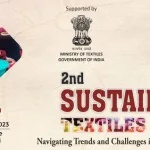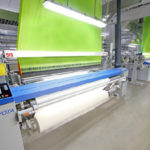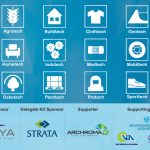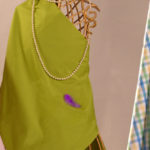The main objective of exploring newer ways to produce apparel textiles is to make the technology oil-independed and also to drastically reduce the water usage. In this respect the use algae as a source material for the production of textiles offers revolutionary advantages. Algae is not oil; algae have a low energy footprint as they are an important part of the carbon flux and grow on CO2 and sunlight (among other nutrients). In addition, algae do not require land based nutrients to grow. Chinese are actively working on harvesting the algae from the congested rivers around Naijing to the cellulose extraction in a local mill to provide a valuable alternative. The project, when successfull, also will provide a source of income to the local people from the algae harvesting. With China taking a lead in exploring huge potential of renewable alginate and the seaweed fibers on a very large scale, algae fibers are predicted to become the third most important natural fiber on the market from nowhere.
Algae are simple plants that can range from the microscopic (microalgae), to large seaweeds (macroalgae), such as giant kelp more than one hundred feet in length. The main varieties of microalgae include both cyanobacteria, (similar to bacteria, and formerly called “blue-green algae”) as well as green, brown and red algae. Algae can be grown using water resources such as brackish-, sea-, and wastewater. This water is not suitable for cultivating agricultural crops. When algae are grown using wastewater, such as municipal, animal and even some industrial runoff, they can help in treatment and purification of polluted water. At the same time, the nutrients present in such wastewater are benefitial for algae harvesting. Most microalgae grow through photosynthesis – by converting sunlight, CO2 and a few nutrients, including nitrogen and phosphorous, into material known as biomass.
There are also efforts to develop eco-friendly textile dyes from algae. California University researchers have developed a biosynthetic indigo dye derived from enzymes produced by bacteria. The technology eliminates the use of hazardous substances used in indigo dye synthesis. It also removes the need for harsh chemical reducing agents for dye solubilisation (see page 11). Blond and Bieber – a Berlin-based design studio has undertaken progect Algaemy to develop a process of turning algae into an eco-friendly and completely non-toxic dye.
Orange Fiber, an Italian firm, founded in 2014, is producing exquisite sustainable fabrics from citrus juice by-products that would otherwise be thrown away, representing hundreds of thousands of tons of precious resources. The 100% citrus textile features a soft and silky hand-feel, light weight, and can be opaque or shiny. The fabrics are perfectly suited to Italian tradition of high-quality fabrics and fashion.
The commercial success of algae fabrics will pave the way for what is called the ‘Blue Economy’ meaning the use of the sea and its resources for sustainable economic development.
G.D. JASUJA
Managing Editor





